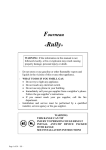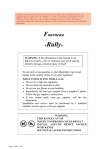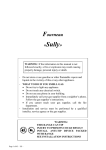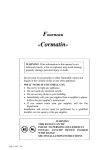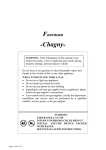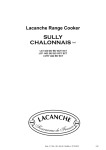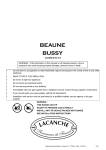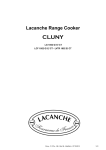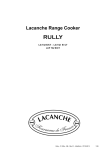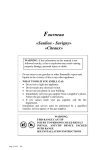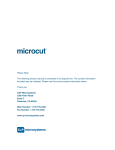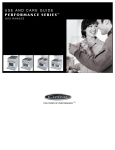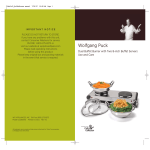Download Fourneau - The French Barn
Transcript
Fourneau « Rully » WARNING : If the information in this manual is not followed exactly, a fire or explosion may result causing property damage, personal injury or death. - Do not store or use gasoline or other flammable vapors and liquids in the vicinity of this or any other appliance. - WHAT TO DO IF YOU SMELL GAS. • Do not try to light any appliance. • Do not touch any electrical switch. • Do not use any phone in your building. • Immediately call your gas supplier from a neighbor’s phone. Follow the gas supplier’s instructions. • If you cannot reach your gas supplier, call the fire department. - Installation and service must be performed by a qualified installer, service agency or the gas supplier. WARNING : THIS RANGE CAN TIP INJURY TO PERSONS COULD RESULT INSTALL ANTI-TIP DEVICE PACKED ! WITH RANGE SEE INSTALLATION INSTRUCTIONS Page 1 of 38 – US – Date: 26/02/10 Page 2 of 38 – US – Date: 26/02/10 700 mm 27’’ 9/16 914 mm* 36’’ 807 mm* 31’’ 49/64 114 mm* 4’’ 31/64 70 mm* 2’’ 3/4 560 mm 22’’ 3/64 Fig. 1 Back spacer (A) Fig. 2 * The range Height is adjustable : 900 mm-35 7/16 ’’ to 916 mm-36 1/16 ’’ Page 3 of 38 – US – Date: 26/02/10 217mm 8’’ 35/64 45mm 1’’ 49/64 Fig. 3 217mm 8’’ 35/64 45mm 1’’ 49/64 Fig. 4 217mm 8’’ 35/64 45mm 1’’ 49/64 Fig. 5 Page 4 of 38 – US – Date: 26/02/10 Layout: 3- or 4-burner cook’s stove above a 68 litre/2.40 ft3 oven and a 35 litre/1.24 ft3 oven (fig.1 & 2). Description: Enamelled steel or stainless body panels AISI 430. Stamped cooking surface (stainless steel AISI 304) (Figure 3, 4 and 5). 3- or 4- burners of different size and power individually controlled by a safety valve. Electronic spark ignition. TRADITION” model equipped with a 385mm x 510mm (15 5/32’’ x 20 5/64’’) heating plate (Figures 5). Electric grill oven: Enamelled sheet metal. Dimensions L x D x H: 400mm (1547/64’’) x 440mm (175/16’’) x 145mm (545/64’’), 35 litres/1.24 ft3, 1 shelf level. Thermostatically controlled heating elements, safety cut-out by safety thermostat. Oven: 1700 W, 2850 Watt electric broiler. Rating: 2850 W – Power supply: 240 Volts 60Hz. Multifunction electric oven: Dimensions L x D x H: 535mm (215/8’’) x 420mm (1627/64’’) x 265mm (1027/64’’); 68 litres/ 2.40 ft3, 3 shelf level with 70mm (2¾”) spacing. Electric broiler with a rating of 2850 W Function static electric oven: One 1700 W element at the base and a peripheral 1200 W element in the roof which operate simultaneously. Thermostatically controlled roof and base heating elements, safety cut-out by safety thermostat. Rating: 2900 W – Power supply: 240 Volts 60Hz. Function ventilated electric oven: Heating provided by one circular 2650 W element located on the back wall surrounding the fan. Thermostatically controlled heating element, safety cut-out by safety thermostat. Rating: 2650 W – Power supply: 240 Volts 60Hz. Accessories Per oven: one roasting pan, one shelf Shipment-Packaging Unpack and check the appliance is in good condition. In case of damage, note any reservations on the delivery note and confirm them within 48 hours by registered letter with confirmation of delivery to the carrier. Appliance Width LG 732/ LG 742 1250 mm / 49,2’’ Depth Height mm Weight Gross/Net 840 mm / 33.1’’ 1070 mm / 42.1’’ 140 kg / 160 kg - 310 / 355 lb Gas connection: 1/2” ID NPT (Sch 40) inlet, on male coupling (Figures 1, 2, 3, 4, 5). Sealant on all pipe joints must be resistive to LP gas. If used, a flex gas line for the gas supply must be metal of at least 1/2” ID NPT approved by an approved certifying agency (A.G.A., C.G.A,. etc.) in compliance with ANSI Z21.41 and Z21.69. Never use a hose made of rubber or other synthetic material. Gas supplying: Appliance gas supply type can be switched, please refer to rating plate and marking at the rear of the appliance. Page 5 of 38 – US – Date: 26/02/10 Electrical connection: On terminal block at the rear of the appliance. Use flexible cord in accordance with standard N.E.C., AINSI/NEMA 70-1996 or latest edition (cord not provided from S.I.L.) (Figures 1, 2, 3, 4, 5). Pressures and hourly consumption: Appliance gas supplying can be switched (table 1). Table 1 PRESSURE 6’’ WC 10’’ WC GAS Natural Gas L.P. Burner Btu / hr Btu / hr Ultra fast (UF) Tradition (T) 18000 17000 Intensive (I) 15000 13000 Fast (F) 11000 10000 Semi fast (SF) 5000 5000 Semi fast Semi fast Ultra Fast Fast Fast Semi fast Ultra Fast Fast Page 6 of 38 – US – Date: 26/02/10 Intensive Fourneau “ Rully “ INSTALLER'S MANUAL Appliances must be installed in a workmanlike manner in accordance with the instructions in this manual and locally applicable regulations. This manual will be handed over to the user after installation. Page 7 of 38 – US – Date: 26/02/10 Page 8 of 38 – US – Date: 26/02/10 Cabinet preparation: B C A N I F G Gas connection on range Place outlet & gas stub-out in this area Fig. 10 H E D J Electrical connection on range A Ø Ø Ø Ø mm 762-914 ’’ 30-36 B C I J 330 457 914 203 273 813 864 51 705 13 2 27¾ 18 D 36 E 8 F 10¾ G 32 H 34 The range is a free standing unit. If the unit is to be placed next to cabinets, the clearances shown in Figure 10 are required. The range cooktop surface must never be lower than the height of the adjacent countertop surface. Min clearances to combustibles: Ø 0’’ (0 mm) from rear. Ø 0’’ (0 mm) from sides below 36’’ (914 mm) countertop height. Ø 2’’ (51 mm) from sides above 36’’ (914 mm) countertop height. Ø Cabinets 13’’ (330 mm) deep may be installed above the range at least 30’’ above the plane of the cooking surface. Use range only with factory supplied legs. Page 9 of 38 – US – Date: 26/02/10 Ø Recommended to be installed under an exhaust hood. IMPORTANT Ø In the Commonwealth of Massachusetts, the appliance must be installed by a licensed plumber or gas fitter. Ø Do not install this unit near combustible walls, partitions, pieces of furniture or decorative material unless these are covered with adequate thermal insulation of the noncombustible type. Ø Make sure the resulting installation meets local fire regulations. IMPORTANT Ø T H E A P P L I A N C E M U S T B E I N S TA L L E D I N ACCORDANCE WITH THE LOCAL CODES OR National Fuel Gas Code, ANSI Z223.1 or latest edition. IMPORTANT Ø Manual shut-off valve should be installed in an accessible location in the gas piping external to the appliance for the purpose of turning on or shutting off gas to the appliance in the event of an emergency. A location at the back of an adjacent cabinet is recommended. Before connection: Check: - Pipework is perfectly clean in order to prevent the injectors becoming blocked and malfunctioning of the magnetic heads. - The gas for which the appliance was set up on rating plate and markings. - Inner diameter of gas supply pipework is compatible with the appliance’s maximum thermal [BTU] output. - Provide adequate air supply [Make-up air] and exhaust ventilation during use of the appliance. Gas connection: Male coupling, Ø 15/21 - 1/2” ID NPT(American) on A (Figure 11). Fuel supply pressure must be no greater than 0.5psi. A After connection: Check the static/dynamic manifold pressure on pressure test connection Ø 15/21 - 1/8” NPT on B (Fig. 12, Table 2). Fig. 11 Change of gas type: The appliance is designed to operate with the gases in Table 2. Table 2 B Country GAS Pressure (Pn) U.S. Natural Gas 6’’ WC U.S. Liquid Propane 10’’ WC Fig. 12 Page 10 of 38 – US – Date: 26/02/10 A pressure regulator (fig. 13) is located in the right rear corner under the hob, to gain access to the pressure regulator, open the cooktop. To open the Cooktop: Remove the grates and burners. Unscrew the screw(s) C on burner UF/ T, I, F or SF (Figures 14 and 15). Pull and raise the top after having loosened the 2 bolts D (Fig. 16), then prop up and support the cooktop. Fig. 13 C C Figure 14 C D Fig. 16 Figure 15 Convertible regulator The reversible cap is labeled either «LP» or «Nat» and is easily recognised by the raised center screw slot (for natural) or the center depth (for LP). To change LP to Natural Gas or vice versa, the seal screw in the regulator lid is unscrewed, reversed and reinstalled to convert from one setting to another (Figures 17 and 18). Fig. 17 Page 11 of 38 – US – Date: 26/02/10 Nat Setting Fig. 18 LP Setting In case of use with a gas other than that for which the appliance was initially set up, it is crucial to replace the orifices and modify the adjustments as defined below. Wrench 12mm (15/32) E TOP BURNERS: Orifice: Lift the air ring E. Replace the injectors F (Fig. 19) in accordance with Table 3 (Ø in 1/100 mm). The side burner bodies are kept in place by a transversal bar (H, fig. 21). In order to take them out, unscrew screws I (fig. 22) then G (fig. 20). Note : When one or more nozzles are changed, the sealing ring should be changed as well (see gas circuit diagram). F Fig. 19 Adjustment of primary air: Refit the burner bodies and burner caps in their respective recesses, adjust the air ring F (Fig. 19) of the burner in accordance with Table 4. Note : Normal flames are bluish violet except for natural gas flames which are pale blue. Fig. 20 Fig. 21 G H Allen 3mm (1/8) Fig. 22 I Hex 7mm (9/32) Table 3 Burners SF Table 4 F I GAS Pressure Natural gas 6" WC 0.90 1.30 1.45 L.P. propane 10" WC 0.65 0.90 1.05 UF/T Ø Page 12 of 38 – US – Date: 26/02/10 Burners GAS Pressure 1.70 Natural gas 6" WC 1.20 L.P. propane 10" WC SF F I UF/T Opening in mm/inches 1.5/ 1/16 6/ 1/4 max 13/ 1/2 3/ 1/8 max max max Adjustment of reduced flowrate of surface burners: After connection or change of gas, it is crucial to modify this adjustment. - Remove the control knob. Light the burner, adjust to minimum setting, then use a small screwdriver to set the adjusting screw J (Figure 23). Note: Flame is reduced to 1/4 of its size in the minimum setting, the burner must remain lit when changing from maximum setting to minimum setting. J Refitting the cooking surface : When refitting the cooking surface, it is vital to tighten fastening screws (figures 13, 14 and 15). Failure to do so can cause distortion of the cooktop. OVEN BURNERS: Fig. 23 Disassembling of the gas oven burner: -Withdraw the baseplate (Fig.24). CAUTION: when refitting, slide the baseplate underneath the lip at the oven front (fig.25). -Unscrew screw K holding the burner (Fig.26). -Remove the drawer. -Loosen the set screw L (Fig.27). -Push the burner towards the back of the oven cavity and lift to raise and release it. Fig. 25 Fig. 24 Fig. 28 L Fig. 26 K Oven Burner Injector: -Remove the baseplate, CAUTION: when refitting, slide the baseplate underneath the lip at the oven front (Fig. 24 & 25). -Remove the screen under the oven floor by removing the two screws at the oven front, the screen rests on two pins at the rear, pull screen forward to remove through the drawer cavity. -Loosen screw L that holds the air collar and pull the air collar forward to gain aces to the injector. -Remove 12mm hex injector and replace with the new one. M Fig. 27 Page 13 of 38 – US – Date: 26/02/10 Pilot Burner Injector: Change the pilot burner orifice Gas pilot LP (0.25mm): 65103032 Gas pilot NG (0.45mm): 65103031 Table 5 Ø GAS Pressure Oven Pilot Natural Gas 6" WC 1.40 0.45 Liquid Propane 10" WC 0.95 0.25 Adjustment of oven primary airflow: Remove the base, loosen the screw L that secures the air collar and then adjust (Table 6, Figure 29). Air Adjustment Fig. 29 Table 6 GAS Pressure Opening in mm / inches Oven Natural gas 6" WC 4 / 3/16 Liquid Propane 10" WC 6 / 1/4 Adjusting pilot burner air supply Turn ring P to fully open for Butane/Propane, to half open for natural gas (Fig. 30 a, b) Fig. 30a P Fig. 30b Page 14 of 38 – US – Date: 26/02/10 ELECTRICAL Ø ALL WORK ON OR REPAIR OF AN APPLIANCE MUST BE CARRIED OUT BY A QUALIFIED INSTALLER. IMPORTANT Ø THE APPLIANCE WHEN INSTALLED, MUST BE ELECTRICALLY GROUNDED IN ACCORDANCE WITH THE LOCAL CODES OR The National Electrical Code, ANSI/NFPA 70-1996 or latest edition. It is hazardous to put the appliance into service without connecting it to suitable ground. No liability can be accepted for accidents resulting from non-compliance with this requirement or incorrect grounding. Before connection, check: Main voltage is compatible with the appliance’s rated voltage and thermal output. Connection: - Use a 4-wire cord rated for 30 A 125 / 250 VAC, type SRD, SRDT, S, SO or ST. - Cord must be agency approved for use with household ranges. - Remove access door O (Fig. 31) with 7mm nutdriver M (Fig. 32). - Remove cable clamp and loosen supply cord mounting screws on the terminal block. - Connect to terminal block in accordance with figure 34. - Secure the cable by means of cable clamp (not provided), item Q (Figure 33). - Refit access door O Fig. 32 Fig 31 Q Fig. 33 Page 15 of 38 – US – Date: 26/02/10 Fig. 34 M BACK SPACER FITTING: It is mandatory to mount a back spacer between the range and the back wall. The back spacer R is supplied with the appliance. Screw the 2 brackets S to the wall according to figures 35, 36 and 37 (screws not supplied), then fit the back spacer vent onto these brackets. S R Figure 36 Figure 35 Figure 37 Page 16 of 38 – US – Date: 26/02/10 SERVICE INSTRUCTIONS: -Lubricating gas valves. If the gas taps tends to stick slightly, you may follow this procedure: • 1 - Shut off the valve and / or the main electrical supply of the unit. • 2 - Take out the knob corresponding to the gas valve to be greased. • 3 - Unscrew the head from the body of the burner valve. • 4 - Grease the tap shaft (High temperature lubricant, for example : SILICAL GEL ™ BARBAHL). Caution! Any excess grease should be removed. Reverse operation 3 to 1 (in that order) to put valve and knob back on. -OVERLIMIT THERMOSTAT: To access internal components and reset the overlimit, lift and secure rangetop. Press pushbutton item U (Figure 38) in order to reset the limiting thermostat. Note: ALWAYS IDENTIFY the reason why the thermostat tripped. U Fig. 38 Page 17 of 38 – US – Date: 26/02/10 GAS CIRCUIT DIAGRAMME Designation Part number Burner cap 1,5 kW 65.330004 Burner cap 3,0 W 65.330005 Burner cap 4,0 kW 65.330006 Burner cap 5,0 kW 65.330007 Burner bowl 1,5 kW 65.640008 Burner bowl 3,0 kW 65.640004 Burner bowl 4,0 kW 65.640005 Burner bowl 5,0 kW 65.640006 Air Collar 65.080005 Mixing tube (1,5-3,0-4,0 & 5,0 kW) 65.064007 Injector holder 65.033018 Sealing ring 65.430007 Injector Dia. 65 65.14964 Injector Dia. 90 65.14969 Injector Dia. 95 65.14970 Injector Dia. 105 65.52863 Injector Dia. 120 65.14973 Injector Dia. 130 65.14974 Injector Dia. 140 65.14975 Injector Dia. 145 65.27781 Injector Dia. 170 65.30546 Brass knob (Gas model) 65.044013 Chrome knob (Gas model) 65.044014 Brass knob (Elec. model) 65.044015 Chrome knob (Elec. model) 65.044016 Regulator 65.103023 All oven burner 73.062010 Injector holder 65.51764 Screw 65.51085 Reducing fitting 65.129099 switch 65.28979 Thermocouple 65.103024 Pilot burner LP 65.103032 Pilot burner NG 65.103031 Oven electrode 65.103004 Spigot rod 59.907379 Page 18 of 38 – US – Date: 26/02/10 65.39895 65.226006 1,5 kW = 65.064007 3,0 kW = 65.064007 4,0 kW = 65.064007 5,0 kW = 65.064007 65.080005 65.033018 65.103033 65.103029 + 4 screws 65.129101 + 4 disc 65.30932 Page 19 of 38 – US – Date: 26/02/10 Détail A : Détail B : 65.103032 (LP) 65.103031 (NG) 65.103033 65.103033 65.103029 Page 20 of 38 – US – Date: 26/02/10 Item n° Designation Part Number B Top burner electrode 65.226006 S1 Switch 65.103030 Page 21 of 38 – US – Date: 26/02/10 Convection & Static Electric Oven (code D) Item n° Designation Part Number TL Three-Pole Limiting Thermostat 65.39942 TH Oven Regulating Thermostat 65.224010 KM Contactor/Relay 65.223001 S2 Selector Switch 65.52194 I Switch 65.222012 R Roof heating element 65.211030 R1 Base heating element 65.211026 R2 Circular heating element 2650 W 65.211028 M Convection Fan Motor 65.260001 H Red LED 65.231004 H1 Orange LED 65.231005 L Oven Interior Lamp 65.232003 Mr Microswitch 65.222011 Page 22 of 38 – US – Date: 26/02/10 « LACANCHE» USER'S MANUAL IMPORTANT Provide adequate air supply during use of the appliance. Provide adequate clearances for servicing and proper operation by not obstructing front or side of appliances. Do not grout or cement range into place. WARRANTY The warranty is stated on the sales contract. Please contact your approved Dealer if any work has to be carried out under warranty. This warranty excludes damage resulting from incorrect installation, improper use or inadequate servicing. Page 23 of 38 – US – Date: 26/02/10 Page 24 of 38 – US – Date: 26/02/10 SAFETY INSTRUCTIONS Ø If the range is to be installed on an area covered with linoleum or any other floor covering, make sure that the floor covering can withstand 90 F (65°C) above room temperature without warping, shrinking or discoloring. Do not install the range over carpeting. Ø Never store anything in the oven or the cooktop. Flammable materials can catch fire, plastic items may melt or ignite and other types of items could be ruined. Ø This appliance is for cooking. Based on safety considerations, never use the oven or cooktop to warm or heat a room. Doing so may result in carbon monoxide poisoning and overheating of the oven. Also, such use can damage the cooktop or oven parts. Ø Never cover any slots, holes or passages in the oven bottom or cover an entire rack with materials such as aluminum foil. Doing so blocks air flow through the oven and may cause carbon monoxide poisoning. Aluminum foil linings may also trap heat, causing a fire hazard. Ø Do not obstruct the flow of combustion or ventilation air to the appliance. Be sure a fresh air supply is available. Ø When using the cooktop, do not touch the burner grates or the immediate surrounding area. Areas adjacent to the burners may become hot enough to cause burns. Ø Do not hang articles from any part of the appliance or place anything against the oven. Some fabrics are quite flammable and may catch on fire. Ø Children should not be left alone in the kitchen while the range is in use. Do not store items of interest to children over the unit. Children climbing to reach items could be seriously injured. Ø Do not use aluminum foil to line any part of the oven or cooktop. Ø When using the oven, do not touch the interior surfaces of the oven, the exterior area immediately surrounding the door or the backtrim. Ø Disconnect from power supply before servicing. Page 25 of 38 – US – Date : 26/02/10 GAS SURFACE BURNERS Highly valued by chefs because of their fast heating and ease of use, gas flame burners have always been traditional heat sources for cooking in large kitchens. Other heat sources have appeared in recent years but just as many users still prefer gas. It offers many advantages; gas provides a fast increase and decrease in temperature. The height of the flame can be checked easily at a glance in order to increase or reduce its power. Lacanche gas hobs on the ranges are fitted with burners of different sizes. These automatically stabilised flame burners offer a very low slow setting to facilitate simmering or high heat for quick sealing. Depending on their size, they are suitable for various types of utensils. Semi fast burner (5k btu): Recommended for small sauceboats, small saucepans or blinis pans for example. A reducing trivet can be placed on the pan support in order to obtain greater stability (see accessories). Fast and Intensive burners (11k, 15k btu): Ideal for shallow frying pans, saucepans and cooking pots. Their high output provides very fast increases in temperature and very flexible use. Ultra fast burner (18k btu): A high-power burner. It is especially recommended when using large utensils up to 40 cm in diameter for slow cooked dishes (pot au feu, cassoulet, jams, etc.) or dishes that have to be sealed quickly (fricassees, fritters, grilled meat). You will quickly learn how to use the various types of burners to achieve optimum cooking. Description: The burners are arranged on a stainless steel hob in various configurations depending on the model. Each burner is equiped with electronic spark ignition. The various types of burners can be identified by their respective diameter. Semi fast Ultra Fast Semi fast Fast Intensive Fast Page 26 of 38 – US – Date: 26/02/10 Designation (btu) Burner diameter Ultra fast (18k) Ø 107 mm Intensive (15k) Ø 90 mm Fast (11k) Ø 72 mm Semi fast (5k) Ø 55 mm Use: Turn on main gas supply to range. Depress handle & rotate burner valve handle anti-clockwise to “IGN” position. Depress handle fully and wait for the burner’s thermocouple to heat up. Hold for 15-20 seconds after flame has lit. Igniters will spark (click) while handle is depressed. Release handle and rotate burner valve handle to “HIGH” position. Depress & rotate burner valve handle to the “LOW” position. To rotate burner valve handle to “Off” position, slightly depress handle then move into “Off” position. A reduced flowrate position identified by the “Low” mark produces the preset minimum burner power. This setting is adjustable behind the knob. Useful hint: Always choose a burner that matches the diameter of the utensil used. CAUTION: During use of the cooking surface or oven, accessible parts may become very hot during use. Warn users of the potential hazards. CLOSE THE MAINS GAS VALVE BEFORE CLEANING Cleaning the cooktop: The burners are made in two parts in order to facilitate cleaning. Clean them separately. After removing the grates and burners, the cooking surface can be cleaned easily and thoroughly by simply using a sponge and soapy water. Do not use scouring pads or abrasive products such as oven cleaners and stain removers. Use a designated stainless steel polish & cleaner to clean the cooktop (brands like: Simple Green & ZEP’S). When cleaning, be careful not to splash liquid into the openings of the burners. Page 27 of 38 – US – Date: 26/02/10 HEATING PLATE DANGER: Temperature may exceed 300°C / 572°F. Warn potential users of hazards involved. The heating plate is a cast iron plate heated by a high-power gas burner. It can be used as a work surface and several saucepans can be placed on it at the same time. Cast iron stores and retains heat uniformly over its entire surface and it is possible to cook or simmer dishes depending on the temperature. Using the heating plate is ideal for cooking a pot au feu, coq au vin, warming a veal or fish stock or even binding a sauce. By removing the central plug of the plate, the burner can be used as an open flame burner. “TRADITION” type gas hobs are equipped with a heating plate. Description: The heating plate is made entirely of cast iron. It consists of two parts, the main part rests directly on the cooking surface and the other removable plug part is located in the middle of the plate. ! ! ! Semi%fast% Ultra&Fast& Heating&plate& ! ! Fast% Page 28 of 38 – US – Date: 26/02/10 Use: The traditional heating plate is coated with a black enamel coating. No maintenance is necessary. Turn gas supply on. Rotate burner valve handle to lighting position “IGN”. Depress handle and turn burner valve handle to full position to shut down burner. Rotate burner valve handle to “OFF” position. A reduced flowrate position identified by the “LOW” mark produces the preset minimum burner power. Cleaning the heating plate: DO NOT USE WATER TO CLEAN THE HEATING PLATE WHEN IT IS HOT. This can damage it. Immediately remove any spillages to make cleaning easier. Use dish soap and water with a sponge to clean. You may use commercially available special products for cleaning cast iron. If the cast iron is heavily soiled, use a solution of 50% white vinegar and 50% warm water with a scouring pad or nylon brush to remove grease before cleaning. Increase the concentration of vinegar for stubborn grease stains. Rinse with water and towel dry after cleaning. Page 29 of 38 – US – Date: 26/02/10 BEFORE USING OVENS In order to achieve optimum use and maximum benefit from your oven, please read the following hints carefully in order to familiarise yourself with the principles of oven cooking. An oven cooks and heats by using a heat source which is generally located inside the oven. This heat source heats the air and then the entire oven. The food therefore cooks thanks to the heat given off by the heating elements but also thanks to heat radiated from the oven walls. This is why it is advisable to: Ø Ø Pre-heat the oven for 15 to 20 minutes depending on the setting selected before placing your dish in the oven. When placing the dish in the oven, make sure that it is not too close to the oven walls in order to prevent the edges of dishes being exposed to excessive radiated heat. Try to place items in the direct center of the oven. The material of which plates and moulds are made influences cooking due to its thickness, ability to transmit heat and its color. Ø Aluminium, earthenware and aluminium with a non-stick coating reduce cooking and underside browning. These materials are recommended for cooking cakes and roasts. Ø Enamelled cast iron, anodised aluminium, tin-plated iron, ovenproof glass, heat-resistant porcelain and aluminium with a non-stick coating and coloured exterior increase underside browning. These materials are recommended in particular for open tarts, quiches and all crispy preparations that must be browned on the underside as well as on the top. In order to prevent smoking due to grease splatters when cooking meat, it is advisable to use pans that have high thermal inertia (earthenware or enamelled cast iron pans) with high edges of a size that matches the item being roasted. Turn red meats over half way through cooking. It is inadvisable to place a pan directly on the base of the oven or to cook items simply placed in the drip tray. These few hints plus your own experience will enable you to achieve excellent results. Danger: When the oven or grill are switched on, accessible parts may become very hot. Keep children away from them. Be careful when handling dishes and racks. Openings or slits for ventilation or heat dissipation must not be blocked. Never store flammable products in the compartment for saucepans Page 30 of 38 – US – Date: 26/02/10 ELECTRIC GRILL OVEN Electric grill ovens are simple to use and are ideal for cooking all usual dishes. The electric grill oven has two heating elements and can be used as both a bake oven and a grill. The electric grill oven is equipped with a broil rack that can be used to grill meats and cook all types of dishes au gratin. It is intended primarily for cooking quiches, pizzas and flans. In grill mode it is perfect for finishing off a crème brûlée or for putting the finishing touch to a dish with a grated cheese topping, grilling small sausages, bacon or toasting or for cooking a rib of beef so that it is just right. The confined space inside the oven enables it to heat up more quickly and reduces the preheating time. In bake mode, dishes are lightly browned by heat refracted from the top of the oven. Description: Made of sheet steel with an acid-resistant enamel coating applied at 850 °C/ 1562 °F; the oven has a capacity of 35 litres/ 1.24 ft3. The electric grill oven is equipped with a broil insert,a drip tray and a rack. Heating in bake mode is provided by one 1200 W element at the base. When used as a grill, heating is provided by one upper 2850 W heating element. All heating elements are controlled by a thermostat switch. The control panel has 2 indicator lamps: - Signal lamp (Red, B) lights when one component is switched on. - Signal lamp (Amber, C) shows status of energised component. Baking Usage: The oven must be pre-heated at the thermostat setting chosen for cooking. 30 minutes average. Turn the thermostat switch clockwise to the required mark. The indicator lamps (B and C) are lit. When indicator lamp (C) is no longer lit, the selected temperature has been reached and you can then place your dish in the oven. In order to switch off, turn the thermostat control knob from the right to the left as far as the Off position. C B Prior to first use of oven: Preheat empty on thermostat setting 220°C / 428°F for 20 minutes, then operate at maximum temperature for approximately 2 hours to heat the rockwool oven insulation and burn off the mineral oil used in the manufacturing process. All odours and smoke will disappear when the oven has been used a few times. Be sure to utilise your ventilation hood during this process. Use: Turn the thermostat control knob clockwise to mark “BROIL”. In order to switch off, return the control knob counter-clockwise to position “Off”. Page 31 of 38 – US – Date: 26/02/10 Useful hints: - Use pans with high edges for roasting in order to minimise grease spatters. - When cooking fruit tarts, place the drip tray at the bottom of the oven in order to collect any spillages. It is also advisable never to place foodstuffs directly in the drip tray. CAUTION, the grill cooks very quickly, always keep an eye on the food you are cooking. Ø Ø Ø Ø Lightly oil the surface of meat and fish before placing them on the broil rack. Only place and use the drip tray under the broil rack in order to collect cooking juices and prevent spillages in the case of food cooked au gratin. Increase the distance between the heating element of the grill and the food to be grilled depending on its thickness in order to avoid overcooking the outer surface without cooking the inside of the food. Keep a careful eye on the food you are cooking; grilling generally does not take long. To remove oven racks: § § § Pull rack forward to the stop position. Raise the forward edge of the rack and lift out. Reverse procedure to install racks. The backstop bar on each oven rack goes toward the rear of the oven. When grilling, the door must be closed and only opened to inspect the foods and then close again. Page 32 of 38 – US – Date: 26/02/10 ELECTRIC MULTIFUNCTION OVEN This oven is switchable between two functions: a static electric function and a forced convection electric function. The volume of the multifunction oven is 68 L / 2.40 ft3. To select the operating function it is necessary to make sure switch A is; on position to operate in static mode, on position to operate in forced convection mode. In the Broil position, only the broil element on the oven ceiling operates regardless of selected mode on switch A. A Static electric oven A Convection electric oven Page 33 of 38 – US – Date: 26/02/10 STATIC ELECTRIC OVEN Electric ovens are simple to use and are ideal for cooking all usual dishes. The electric oven has three heating elements and can be used as both a bake oven and a broil. The electric oven is specially recommended for dry pastries such as almond biscuits, Genoese sponges, etc. Description: The electric oven is supplied equipped with one rack, one pastry sheet and one drip tray as standard. The heating elements consist of one 1700 W element at the base and a peripheral 1200 W element in the roof which operate simultaneously. The heating elements are controlled by a thermostat switch. There are 2 indicator lamps on the control panel of the electric oven: - Signal lamp B lights when the components are switched on. - Signal lamp C shows status of energised component. It is lit or not lit depending on the programmed temperature. Use: The oven must be pre-heated at the thermostat setting chosen for cooking. Switch the mode selector switch to “static” position. Turn the thermostat switch clockwise to the required mark. The indicator lamps (B and C) are lit. When indicator lamp (C) is no longer lit, the selected temperature has been reached and you can then place your dish in the oven. In order to switch off, turn the thermostat control knob counterclockwise to the Off position. C B Static position Prior to first use of oven: Preheat empty on thermostat setting 220°C/428°F for 20 minutes, then operate at maximum temperature for approximately 2 hours to heat the rockwool oven insulation and burn off the mineral oil used in the manufacturing process. All odours and smoke will disappear when the oven has been used a few times. Page 34 of 38 – US – Date: 26/02/10 Useful hints: - Use pans with high edges for roasting in order to minimise grease splatters. - When cooking fruit tarts, place the drip tray at the bottom of the oven in order to collect any spillages. It is also advisable never to place foodstuffs directly in the drip tray Electric grill: The electric oven is equipped with a grid that can be used to grill meats and cook all types of dishes au gratin. The electric grill is ideal to finish off crème brûlées or obtain perfect cooking of a rib of beef for example. Use: Turn the thermostat control knob to mark “BROIL” In order to switch off, return the control knob to position Off. Useful hints: CAUTION, the grill cooks very quickly, always keep an eye on the food you are cooking Ø Ø Lightly oil the surface of meat and fish before placing them on the sliding grid Only place and use the drip tray under the grid in order to collect cooking juices and prevent spillages in the case of food cooked au gratin. Ø Increase the distance between the heating element of the grill and the food to be grilled depending on its thickness in order to avoid overcooking the outer surface without cooking the inside of the food. Ø Keep a careful eye on the food you are cooking; grilling generally does not take long. To remove oven racks: § § § Pull rack forward to the stop position. Raise the forward edge of the rack and lift out. Reverse procedure to install racks. The backstop bar on each oven rack goes toward the rear of the oven. When grilling, the door must be closed and only opened to inspect the foods and then close again. Page 35 of 38 – US – Date: 26/02/10 ELECTRIC FORCED CONVECTION OVEN The forced convection oven is a recent development in cooking techniques. Its principle is straightforward: air circulates over a heating element, is heated when it comes into contact with the element and the heat thus obtained in the oven is used to cook food. Air circulation is achieved by using one turbine inside the oven which draws in air and expels it onto one 2650W, 3 loop heating element, thus producing movement of warm air referred to as “convection”. Forced convection ovens have many advantages, the main benefit being that identical or different dishes can be cooked evenly at several levels. It is therefore particularly suitable for cooking cakes, pastries, Viennese bread or flaky pastry. It heats quickly and defrosts frozen food evenly. Baking times are reduced by 25% compared to a static oven. Different dishes can be cooked simultaneously without taste transference because odours are incinerated as the air passes over the 1,100+°F heating element. Description: The forced convection oven is equipped with one rack, one pastry sheet and one drip tray as standard. The oven is heated by one circular 2650 W element. The heating element is controlled by a thermostat switch. There are 2 indicator lamps on the control panel of the electric oven: - Signal lamp B lights when the components are switched on. - Signal lamp C shows status of energised component. It is lit or not lit depending on the programmed temperature. Use: The oven must be pre-heated at the thermostat setting chosen for cooking. Switch the mode selector to “convection” position. Turn the thermostat switch clockwise to the required mark. The indicator lamps (B and C) are lit. When indicator lamp (C) is no longer lit, the selected temperature has been reached and you can then place your dish in the oven. In order to switch off, turn the thermostat control knob from the right to the left as far as the Off position. C B Convection position Useful hints: Prior to first use of oven: Preheat empty on thermostat setting 220°C/428°F for 20 minutes, then operate at maximum temperature for approximately 2 hours to heat the rockwool oven insulation and burn off the mineral oil used in the manufacturing process. All odours and smoke will disappear when the oven has been used a few times. Page 36 of 38 – US – Date: 26/02/10 Grill (option): Turn the control knob clockwise to the BROIL position. To switch off, turn the control knob counter-clockwise to the Off mark. To remove oven racks: § § § Pull rack forward to the stop position. Raise the forward edge of the rack and lift out. Reverse procedure to install racks. The backstop bar on each oven rack goes toward the rear of the oven. Useful hints: When cooking different dishes simultaneously, preferably place cakes and pastries at higher levels above other items to be cooked. If the cooking times of dishes vary, place them in the oven so that they are cooked just in time to serve them and remove them as soon as they are ready. In a forced convection oven, cooking can take place quicker than in a conventional oven. Consider reducing the heating temperature for better heat penetration into a thicker dish. - Use pans with high edges for roasting in order to minimise grease splashes (e.g. casserole without lid). - When cooking fruit tarts, place the drip tray at the bottom of the oven in order to collect any spillages. - It is also advisable never to place foodstuffs directly in the drip tray. CAUTION: The grill cooks very quickly and the user must always keep an eye on it. Page 37 of 38 – US – Date: 26/02/10 CLEANING BEFORE ANY CLEANING WORK, CLOSE THE GAS SUPPLY AND/OR ISOLATE FROM THE MAINS SUPPLY Oven: Use no abrasive cleaners on the oven walls. Special oven cleaning foams or gels (i.e. Easy-Off) may be used but should be kept away from the heating elements. Towel dry and wipe away cleaning foam or gel after the cleaning process is complete. Remove the oven door gasket when using foams or gels. DO NOT USE a metal knife, spatula, or any other metal tool to scrape stainless steel. Scratches are almost impossible to remove. Clean the rear cover (electric oven or fan-assisted oven) with a pre-treated towel to ensure that the cooling louvers are not blocked. Do not spray cleaner directly through the louvers in the rear cover. Burners: Brass Caps: Use soap and water and a Scotch-Brite® pad to clean the caps. A brass cleaner and polish can be used but will only effect the buildup of tarnish or oxidation. The brass caps reach a very high operating temperature and slowly temper with usage, which will slowly change the color of the metal from a shiny gold to a matte brown. Aluminium Bowls: Use soap and water and a Scotch-Brite® pad or products like Barkeeper’s Friend® and a nylon brush to clean the irregular surface of the burner bowls. If the aluminium is heavily soiled, use a solution of 50% white vinegar and 50% warm water with a scouring pad or nylon brush to remove grease before cleaning. Increase the concentration of vinegar and soak for stubborn grease stains. Rinse with water and towel dry after cleaning. Trim: Brass: Use mild metal cleaners and polishes similar to MOTHER’S® Mag & Aluminium Polish. Will not react to colored enamelled panels. Use as directed. Body panels: Stainless Steel: You can use special-purpose products for stainless steel (e.g. ZEP’S STAINLESS STEEL®, JOHNSON STAINLESS STEEL®, SIMPLE GREEN STAINLESS STEEL®). Never use abrasive products. Enamelled surfaces: Use non-ammonia glass cleaner or dish soap & water to clean the colored enamelled panels. Caution: Cast iron and brass cleaners affect and modify the color of enamelled parts. Immediately rinse abundantly with water and do not rub to remove inadvertent splashes or runs. Heating plate: Follow instructions when using this equipment in the beginning. Use a special cast iron cleaner such as ZEBRACIER or Le Creuset® Enameled Cast Iron Cookware Cleaner for normal cleaning. If the cast iron is heavily soiled, use a solution of 50% white vinegar and 50% warm water with a scouring pad or nylon brush to remove grease before cleaning. Increase the concentration of vinegar for stubborn grease stains. Rinse with water and towel dry after cleaning. CAUTION Use NO chlorinated cleaners to clean this unit. Page 38 of 38 – US – Date: 26/02/10






































